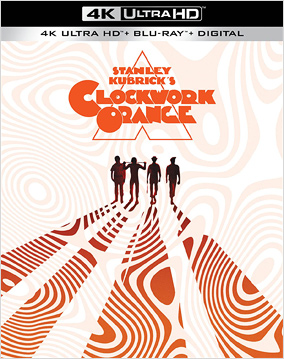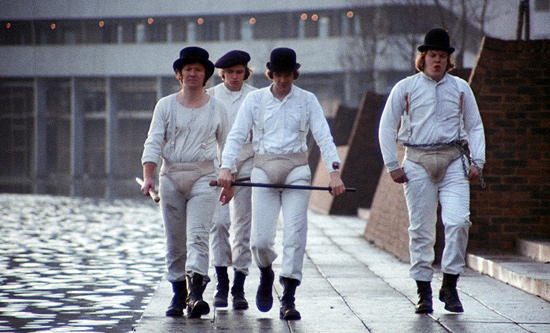
The Digital Bits: In what way is A Clockwork Orange a significant motion picture?
Benson: Quite simply, it’s significant because it’s a Stanley Kubrick film. Anything Kubrick made is significant because it’s generally accepted that Kubrick is one of the great filmmakers. As Martin Scorsese commented in Jan Harlan’s excellent documentary, Stanley Kubrick: A Life in Pictures, Kubrick was on the radar of anyone interested in cinema after Paths of Glory had hit theaters. As Kubrick continued to make challenging films such as Lolita, Dr. Strangelove, and then 2001, Kubrick became the guy on the pedestal to young filmmakers in film school. After 2001, any picture made by Kubrick was an event, and you made it a point to see it. A Clockwork Orange was made when Kubrick was at the height of his powers.
Sheldon Hall: On first release in London A Clockwork Orange played 61 weeks—the longest run in the world—in the 890-seat cinema Warner West End, earning £466,917 (about $1 million, or about $7 million adjusted for inflation).
Cork: A Clockwork Orange may be the most thought-provoking film on the subject of toxic masculinity ever made. Of course, that term didn’t exist when the film came out, but the concept of unchecked masculine desire, of the unbridled id of males of a certain age, of testosterone-fueled raping and senseless brutality has never been presented both so seductively and so repulsively and addresses in such a way that it turns a mirror back on the viewer over and over again, eluding simple answers and safe conclusions. Because it presents a set of moral conundrums that force us to confront our ever-shifting emotional reactions to Alex and his violence, the film makes the viewer work to find meaning in the chaos of Alex’s rampages, the indifference of governmental bureaucracy, the self-serving nature of politics, the self-absorption of the rich, and our own ugly desires for consequence-free vengeance.
The Digital Bits: How does the film compare to the source material?
Cork: The novel is indisputably brilliant. It arrived after nearly a decade of headlines about violent youth gangs in the UK after World War II. Originally called Cosh Boys, the Teddy Boys caused tremendous hand-wringing among the press and politicians after The Notting Hill Riots of 1958, which lasted nearly a week. The Teddy Boys were ruthlessly violent, had their own slang and style, and were obsessed with music (rock ‘n roll, not classical). Burgess’s novel showed up in 1962, just four years later, and rather than write about the actual Teddy Boys, Burgess created his own youth gangs in a future that very well reflected the social strata of post-war Britain.
Benson: I mentioned that the Anthony Burgess novel was “unfilmable,” but Kubrick did it. The film is quite faithful, although Alex and his Droogs are much younger in the book than in the film. It should be noted that Kubrick worked from the American publication of the book, which was missing the final chapter. In that deleted chapter, Alex is grown and no longer interested in “horrorshow” violence. The U.S. publisher had found the chapter unnecessary (and I agree!) and cut it out. The British edition of the novel still includes those final pages. So, the film ends with the irony (something Kubrick excels in) of Alex reverting to his old ways after being “cured all right.” (Wink.)
Krämer: Anthony Burgess’s novel is, perhaps more than anything else, about language, especially the odd slang that the first-person narrator and protagonist Alex uses. This element is still present in the film but, of course, the powerful sensual impact of its sounds and images is much more important. As a reader of the novel, all I have is Alex’s point of view and the often rather incomprehensible—or at least difficult-to-understand—language he uses. Sometimes I will not grasp all-too-clearly what he is saying, and what is actually happening in the story. And I am likely to be more or less detached from those happenings. In fact, even horrendous torture and sexual violence may come across rather humorously or lyrically due to the quirky, inventive, clever expressions Alex uses in his telling of the story. The film viewer’s experience, especially of sex and violence, is much more in your face (and ear), and while the film as it is clearly is shocking, it has massively toned down the novel’s sex and violence. There is also, of course, the debate about the novel’s final chapter, which is present in the original British edition but not in the original American edition, and which seems to be very explicit about the moral (or message) of the story. Burgess could not decide which version to publish, so he didn’t mind (at least not initially) when both appeared. Kubrick decided not to use that final chapter, and in general, I would say, the film is rather ambiguous about what we, as viewers, are to make of Alex’s development towards the end of the story: will he go back to his old ways, or has he changed in some fundamental way. A lot of people seem to think they know which way it is (namely the former) and what the moral of the film is—but, personally, I think that there are a lot of clues telling us that Alex has indeed changed, and that, if the film does indeed have a message, it has to do with a final ambiguity. In fact I think that this applies to much of what we encounter in the course of the film. Unfortunately, both Burgess and Kubrick talked an awful lot about what novel and film were meant to say—thus reducing, even denying the complexity and radical openness of the film.
Cork: There are many things in the novel that are harsher than the sex and violence shown in the film. Alex and his Droogs rape ten-year-olds, for example. They also commit robberies for profit. But Burgess has a very different, and more optimistic take on the ending. Despite all that has happened, at the end, Alex is a somewhat changed person, now focused on growing up and settling down, compared to the implication that he has been returned to his monstrous state in the film. All that said, much of the dialogue is word-for-word from the novel. Kubrick was very respectful of the source material.
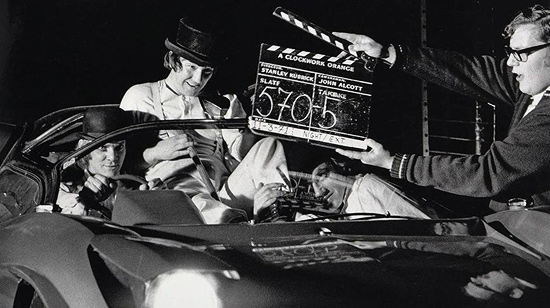
The Digital Bits: In what way was Kubrick an ideal choice to direct?
Hall: A recession in the industry led MGM to cancel Kubrick’s planned biopic of Napoleon and he turned instead to adapting Anthony Burgess’s satirical fantasy A Clockwork Orange. The resultant film embodies all his worst tendencies: it is glib, vulgar, schematic, misanthropic, over-designed, and evades confronting the full implications of its subject—the necessity of free choice between good and evil—by dealing in grotesque cartoon caricatures rather than human beings.
Cork: Kubrick was a visual poet. He obsessed over the details within an image. There are few directors who understood the technical aspects of putting an image on film better. Having started out as a still photographer, Kubrick knew lenses, film stocks, lighting, camera rigs as well as most directors of photography. Despite his reputation for meticulousness and endless takes, Kubrick was a surprisingly efficient director. He would rather take a tremendous amount of time to capture one brilliant shot than use the same time to do a lot of okay coverage. So you get numerous scenes captured in one shot in one take.
Benson: A Clockwork Orange is easily one of Kubrick’s greatest accomplishments. Interestingly, it was almost an afterthought of his to make it. He had planned to make an epic picture about Napoleon right after 2001: A Space Odyssey and spent two years in pre-production on that before MGM got cold feet and pulled the plug. Then, Kubrick made his unprecedented deal with Warner Brothers to make films exclusively for that studio. To show them that he could make a movie cheaply and quickly, and to capitalize on the current and trendy “youth film” market (i.e. Easy Rider, etc.), he chose to make A Clockwork Orange. He made it in six months (a very short time for Kubrick!) and for around two million pounds sterling, which at that time was not even $1.5 million U.S. When you view the film, it’s extraordinary to think that it cost so little. It looks like an expensive movie.
Krämer: We owe the film to Kubrick’s failure to get financing for Napoleon; and perhaps this is just one of those lucky failures that lead to something unexpectedly good.
Cork: Kubrick was also great with actors. He found actors he trusted, then pushed them to deliver incredibly nuanced performances. While in 2001: A Space Odyssey, Kubrick had the actors embody the confined, emotionless, sexless aspects of space exploration, in A Clockwork Orange Kubrick gets brilliant comic performances. All the characters reflect their essential nature in larger-than-life ways that still feel true, whether it is Alex’s passion for ultra-violence or the simmering frustration of P.R. Deltoid, the “Post-Corrective Adviser,” or the smug pomposity of the Minister of the Interior. You don’t get that kind of consistency of performances across a film without a director who understands how to get actors to give their very best.
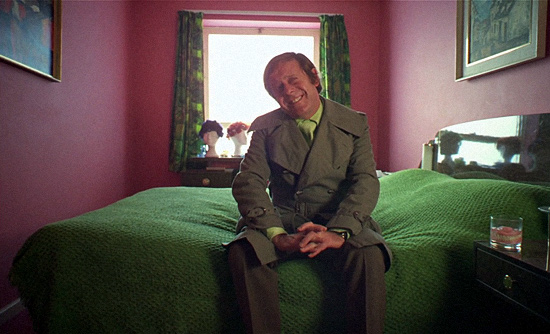
The Digital Bits: Which are the film’s standout scenes?
Cork: I feel this film is as near-perfect as can be. Every scene stands out to me.
Benson: The first half hour is such iconoclastic filmmaking that it dazzles and assaults the audience with sight, sound, color, violence, comedy, and horror. One can barely catch a breath after those opening sequences that establish exactly what Alex and his Droogs are all about. It’s as if the movie itself has been drinking the “Moloko Plus” and is on a supercharged high. It’s only after we see Alex at home with his parents that the pulse of the film “comes down” to tell its story. I can’t find any flaws in any scene in the film. It’s perfect.
The Digital Bits: What are your thoughts on Malcolm McDowell’s performance as Alex?
Benson: Alex was the role McDowell was born to play. He is still trading on his performance today, appearing at horror conventions and such to sign autographs. When I interviewed him he admitted that he never had another role as good, and that it was a “once in a lifetime” part. And he’s brilliant in it. I’m still flabbergasted that he wasn’t nominated for an Oscar.
Cork: With all due respect to McDowell’s brilliant career and tremendous talent, I’ve never seen him dominate the screen the way he does in A Clockwork Orange. Of course, playing a character like Alex is often a once-in-a-lifetime opportunity. McDowell’s Alex strikes just the right balance of confidence, swagger, sarcasm, and the facile ability to deliver to others what they wish to hear. He knows how to play the victim and victimizer for all it is worth.
The Digital Bits: Any thoughts on A Clockwork Orange as a home-viewing experience?
Cork: I first saw A Clockwork Orange on a 4x3 television in my grandparent’s living room late at night. The film mesmerized me then. I college, I saw it repeatedly at revival houses and at campus screenings. I once watched it on a seatback screen on a transatlantic flight. Most recently, I watched it on HBO Max on a very nice 4K television. This may sound like sacrilege, but the film blows me away every time I see it, no matter the format.
Benson: The film is very well represented on home video. The 40th Anniversary Blu-ray that came out ten years ago is excellent. It’s gorgeous. I understand that the new 4K Ultra looks magnificent (I haven’t seen it).
Cork: There is a great new documentary, A Forbidden Orange, about the release of A Clockwork Orange, particularly whether it would appear at a festival in Spain. I would love to see more done about the film and its legacy, but I am unsure whether a Blu-ray release is the proper way to accomplish this.
The Digital Bits: How would you describe A Clockwork Orange to someone who has never seen it?
Cork: I would simply say it is one of the most thought-provoking films I’ve ever seen. Within the past six months, I’ve shown the film to someone who had never seen it. I warned them it was violent, but the violence is there not in a pornographic way, but to make you think about violence, and all the different levels of violence from the personal violence humans visit upon each other to societal violence that happens at all sorts of other levels.
Benson: I’d say that A Clockwork Orange is a one-of-a-kind movie that is unlike anything else. It’s a story about crime and punishment, and if the government should have medical control over man’s choices of free will. It’s a movie filled with irony and dark comedy, but it’s also horrifying and disturbing. I would first make sure the viewer is familiar with Stanley Kubrick and his work, and then I would prepare them for the “assault” on the senses they are about to see. I feel that today I would need to warn them about the violent rapes, and that most of the serious violence is finished after the first twenty minutes.
The Digital Bits: What do you think is the legacy of A Clockwork Orange?
Hall: The film’s cult reputation was enhanced in Britain by the director’s ban on its UK exhibition from 1973 until a posthumous reissue in 2000. The willingness of Warner Bros—financier and distributor of this and all his subsequent projects—to indulge him speaks volumes about Kubrick’s unique status.
Benson: Stanley Kubrick did a brilliant thing with A Clockwork Orange. In the first 20-30 minutes of the film, he shows the audience this really horrible person, Alex, who is a villain in the worst way. He commits shocking crimes, one after the other, boom boom boom, and for some it can be stomach-churning. Then, the movie calms down, and Alex, who has been addressing the audience in first-person narration since the beginning, embraces the viewers as friends, and he takes us into his confidence. We begin to like the guy. By the middle of the movie, the audience is actually rooting for him. By the end, Kubrick is laughing at us, saying, “Ha, I fooled you! I got you to empathize with a horrible criminal who is addicted to violence,” which puts the viewer in the same shoes as Alex himself. Kubrick shows us how easy it is for base instincts to move to the dark side. He gets us to exchange the roles of protagonist and antagonist in the film, with Alex becoming the “hero” and the corrupt government and doctors who experiment on him as the villains. Irony. Pure Kubrick.
Krämer: The film has resonated across popular culture in so many different ways, most especially through the iconic figures of the Droogs, the brutal thugs that make up Alex’s gang of juvenile delinquents. Already when the film was initially released in the UK, youth started to copy their dress—but not their violent behavior (although there was a great deal of public concern that this would follow). Later, in the UK and elsewhere, Halloween costumes and hardcore football fan groups echoed the Droogs’ outfit. Across the decades, various bands paid homage, in their names, their music and their dress code, to A Clockwork Orange in general and the Droogs in particular (in fact, David Bowie did so already in 1972/73). Even in academic circles, there is sometimes a tendency for writers to associate themselves with, and to express a certain admiration for the Droogs—which is actually quite unsettling, given the fact that the Droogs are brutal criminals, rapists and murderers. So both within and beyond film culture, there is something deeply unsettling still about the impact A Clockwork Orange has had and continues to have. It is not simply a masterpiece cocooned in a discourse about art and the cinematic canon—it is still disturbingly visceral and resonant; and it is not even necessary to have actually seen the film for this resonance to be felt.
Cork: When a film of such an iconic nature arrives, it tends to stand alone. You see other filmmakers attempting to play with the universe created by Kubrick and Burgess, sometimes directly in the portrayal of the gangs in Walter Hill’s The Warriors, or, less directly, in the far superior The Wanderers, both from 1979. You see a great deal of Alex in Heath Ledger’s performance as The Joker in The Dark Knight. Tarantino was playing with the Singin’ in the Rain scene for a similar set piece in Reservoir Dogs. Trainspotting also has some visual hat-tips. Yet, I don’t see the film itself as something that created a movement. Airport launched the disaster film genre. The Godfather spawned a slew of gangster films. A Clockwork Orange, not so much. Now, fifty years on, we are left with a baffling appearance by Alex’s Droogs in Space Jam: A New Legacy. Some of the scenes seem to pop up in parodies, music videos, television comedies, particularly someone strapped to a chair, eyes opened, forced to watch something they dislike.
The real legacy, though is censorship, and the very ironic story of how the film of A Clockwork Orange both omitted a key part of the novel and then later disappeared from British screens for nearly thirty years. This is a complex story that is, for me, intrinsically linked to the themes of the movie itself.
The film centers around society’s futile attempts to control Alex and the chaos he creates. He is eventually compelled to give up rape and violence through “aversion therapy” (called the Ludovico Technique in the novel and film). This is a concept born out of a branch of psychology called Behaviorism. The Behaviorists believe that rather than diving deep into the root causes of destructive behavior, it is generally more effective to mentally train folks not to engage in the behaviors. Thus, a drug that will make one feel deathly ill if one drinks may cure alcoholism much faster than years of therapy to understand why one drinks too much. Well, in the 1960s, there was much fretting over these concepts. Could Behaviorism be used by a government to take away free will? Can it leave us defenseless and unable to make our own choices? Can the government “censor” our behavior through techniques like those portrayed in A Clockwork Orange?
Of course, censorship in the classic sense is a government deciding what we can watch, read, hear, and many governments did ban or censor the film version of A Clockwork Orange. The UK did not censor it, despite outcries at the time from many that violent films were polluting the nation’s movie-going population. When the press seized upon a couple of brutal crimes that may have been tenuously linked to the film, and protesters came after Kubrick and his family, the director himself requested that the movie be pulled from British distribution. It was never legally screened in the UK again until after Kubrick’s death. Even prior to that time, Burgess claimed his American publisher requested that the final chapter be deleted, and this incomplete version was the novel Kubrick read. He did not read of Alex musing on growing up and out of his violent phase, an ending that promoted the notion that Alex would, given a bit of time, mature into a contributing member of society.
Just as in the film, where Alex does everything he can to undergo the treatment so he can leave prison, Burgess claimed in the 70s and 80s that he reluctantly accented to cutting the last chapter in the novel, and Kubrick was, ultimately, the censor of the film in the UK. Burgess’s cuts to the novel and Kubrick’s pulling of the film were in reaction to certain real-life forms of aversion therapy. In Burgess’s case, it was, he claimed, to appease a publisher with access to the huge US market (although there is strong evidence that Burgess was, at best, ambivalent about the need for his deleted last chapter when he wrote the book and did not include it in his own screenplay version of the story). In Kubrick’s, it was reportedly death threats and a barrage of negative press. This happens today, too. A singer changes lyrics to a song because some on Twitter lambast her for using a certain word many find offensive. A celebrity issues some “heartfelt” apology for a joke because of blowback on social media. A publisher pulls a couple of classic children’s books because a few are loudly objecting to some of the original illustrations. Clearly, aversion therapy works at modifying behavior, but as A Clockwork Orange asks, at what cost?
Burgess and Kubrick wanted to show us the worst of the worst, a deeply unlikable character, and make the argument that even his freewill was something a government shouldn’t take away, and that everyone’s freewill is something for which we should care. Yet, when faced with pressure from a publisher or a segment of an outraged public, these creators censored themselves. Did they make the right choices? I am not here to judge, but it is just this kind of moral ambiguity that makes A Clockwork Orange and the real-life story behind it so captivating to me.
The Digital Bits: Thank you—Raymond, John, Sheldon and Peter—for sharing your thoughts about A Clockwork Orange on the occasion of its 50th anniversary.
---END---
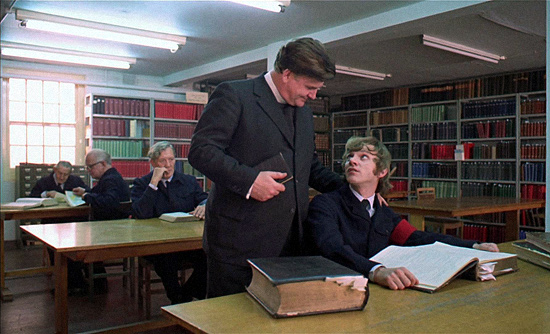
IMAGES:
Selected images copyright/courtesy Hawk Films, John Hazelton, Polaris Productions, Warner Bros. Pictures, Warner Home Video.
SOURCES/REFERENCES:
The primary references for this project were the motion picture A Clockwork Orange (Warner Bros., 1971), regional newspaper coverage, trade reports published in Boxoffice, The Hollywood Reporter, and Variety, and interviews conducted by the author. All figures and data pertain to North America (i.e. United States and Canada) except where stated otherwise.
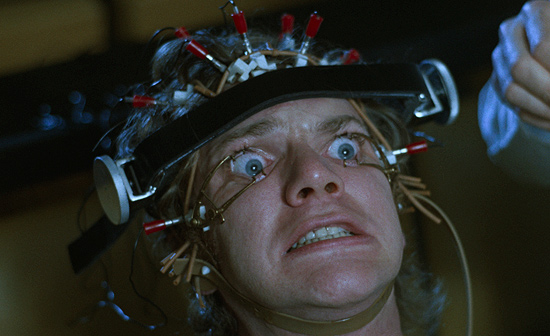
SPECIAL THANKS:
David Ayers, Don Beelik, Raymond Benson, Diane Buckley (Virginia Beach Public Library), Lanham Bundy (Providence Public Library), John Cork, Shane Curtin (San Jose Public Library), Sheldon Hall, John Hazelton, Isaac (Buffalo & Erie County Public Library), Peter Krämer, W.R. Miller, Gabriel Neeb, Jennifer Pawlowski (Tulsa City-County Library), John Wilson (Jacksonville Public Library).
IN MEMORIAM
- Neil Wilson (“Prison Check-in Officer”), 1916-1975
- Paul Farrell (“Tramp”), 1893-1975
- Michael Bates (“Chief Guard Barnes”), 1920-1978
- John Barry (Production Designer), 1935-1979
- James Liggat (Casting), 1920-1981
- Patrick Magee (“Frank Alexander”), 1922-1982
- Anthony Sharp (“Frederick, Minister of the Interior”), 1915-1984
- Lindsay Campbell (“Police Inspector”), 1927-1984
- John Alcott (Lighting Cameraman), 1930-1986
- Michael Grover (“Prison Governor”), 1913-1987
- Peter Burton (“Junior Minister”), 1921-1989
- Bill Rowe (Dubbing Mixer), 1931-1992
- Anthony Burgess (Novelist), 1917-1993
- Madge Ryan (“Dr. Branom”), 1919-1994
- Godfrey Quigley (“Prison Chaplain”), 1923-1994
- John J. Carney (“Detective Sergeant”), 1940-1995
- Sheila Raynor (“Mum”), 1906-1998
- Stanley Kubrick (Writer-Producer-Director), 1928-1999
- Philip Stone (“Dad”), 1924-2003
- Lee Fox (“Desk Sergeant”), 1912-2003
- Barrie Cookson (“Dr. Alcott”), 1922-2005
- Max L. Raab (Executive Producer), 1925-2008
- Miriam Karin (“‘Catlady’ Weathers”), 1925-2011
- Margaret Tyzack (“Conspirator Rubinstein”), 1931-2011
- John Clive (“Stage Actor”), 1933-2012
- Vivienne Chandler (“Handmaiden in Bible Fantasy”), 1947-2013
- Warren Clarke (“Dim”), 1947-2014
- Bernard Williams (Associate Producer), 1942-2015
- Aubrey Morris (“P.R. Deltoid”), 1926-2015
- Adrienne Corri (“Mary Alexander”), 1931-2016
- Pauline Taylor (“Psychiatrist”), 1935-2017
- Bill Butler (editor), 1933-2017
- Carl Duering (“Dr. Brodsky”), 1923-2018
- David Prowse (“Julian”), 1935-2020
- Russell Hagg (Art Director), 1938-2022
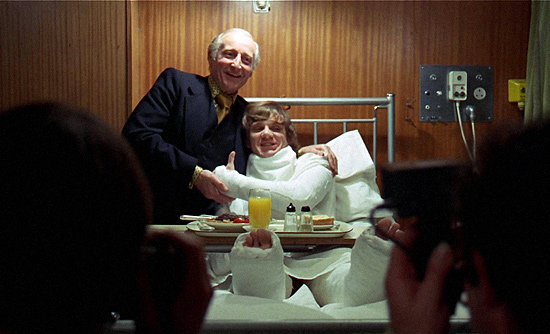
- Michael Coate
Michael Coate can be reached via e-mail through this link. (You can also follow Michael on social media at these links: Twitter and Facebook)



